OCR from source scans:
Already many million Timex watches are in service throughout the world and each year this quantity is rapidly increasing. With so many in circulation, a large proportion of repairs taken into jewellers will consist of Timex watches. An effective and efficient repair service is essential, based on techniques formu-lated after many years of factory servicing.
Even with the most rugged of watches, as with all mechanical devices, sometimes it will require a servicing operation to cover for mishandling, damage, oiling or wear, etc.
To present the Timex servicing procedure in as few words as possible for persons who are already skilled in watch repair, we have prepared a series of illustrative drawings showing those areas in which you may need guidance.
Cases
The Timex waterproof, self-wind and non-waterproof range of watches all feature conventional designs of watch case with which all jewellers are familiar. As these styles change each year to meet changing tastes of customers, detailed methods of uncasing are not shown. Although styling changes, the basic method for casing and uncasing watches remains the same.
It is important to note that every Timex, when completed at the plant, is sub-jected to electronic timing tests and is run tested in several positions, including horizontal and vertical positions, to establish accurate timekeeping. In addition, all waterproof cases are individually tested to 21 Atmospheres in accordance with British Standard No. 3637-1963, equivalent to immersion in water to a depth of 85 feet. Every non-waterproof watch is dust protected by means of a dust seal which is located around the winding stem. Sketches showing the various types used are included in this section.
Every Timex is fitted with a crystal which has been developed to resist crazing and shrinkage.
Every watch has an unbreakable mainspring which gives a consistent torque output and an average running time of 42 hours.
Movements
Illustrations show the Timex movement is of two plate design, whereas most conventional watches feature the bridge design.
The two plate design is most important as it ensures interchangeable accuracy for gear train and escapement, no further adjustment of escapement is necessary, the correct locking engagement between pallet pins and escape wheel is ensured, thereby facilitating servicing. The use of individual bridges may require selective fitting and special adjustments.
As described later, it is necessary only to remove the balance wheel assembly, cannon pinion, ratchet wheel bridge, ratchet wheel and click.
It is seldom necessary to remove other parts except those mentioned. However, these parts must always be removed for movement cleaning.
Timex has found through long and careful research the best method of cleaning the movement is with only the forementioned parts removed (i.e. with barrel and mainspring in place). The cleaning method, while removing any contami-nation from the movement will also remove oil from the train holes and bearings. Since the mainspring is not capped, oil will also be removed from this area and re-oiling is required. In the case of the barrel, special holes are provided to accomplish this. For the self-wind movement, it is essential that oil be applied to the slipping tail of the mainspring to ensure correct function.
In the event that it is necessary to remove the pallet lever and escape wheel, illustrations are included showing this operation, indicating removal and replace-ment.
However, should it be necessary to completely dismantle the movement, the illustrations in this section will guide further servicing.
In the event that complete dismantling is required, it is recommended that the dial plate be removed, thus fully exposing the gear train and associated parts. To reassemble, start with the movement plate. Normal care should be exercised to ensure proper location of the pivots in their respective hole positions in the plates.
Research and development are continually in progress, investigating new materials, new processes, etc. As these new features become thoroughly tested under simulated long term field conditions they will be introduced into the movement as part of the Timex programme, to ensure that latest technical developments are incorporated in these products.
MODEL 22 MOVEMENT
9 x 10 LIGNE
Illustrations with descriptive notes show the following:
- Plate I – Completely exploded view of movement.
- Plate II – Removing crown and stem.
- Plate III – Correct location for dust seal.
- Plate IV – Remove dial and movement assembly.
- Plate V – Power release from the mainspring.
- Plate VI – Removing balance wheel.
- Plate VII – Change balance wheel.
- Plate VIII – Removing pallet lever and escape wheel.
- Plate IX – Change pallet lever and escape wheel.
- Plate X – Refitting cannon pinion.
As stated previously, with only the balance assembly, cannon pinion, ratchet wheel bridge, ratchet wheel and click removed from the movement it is possible to clean thoroughly and efficiently without further dismantling. For this purpose the use of a cleaning machine is advantageous but not an absolute necessity.
The movement should be placed in the cleaning basket with the dial plate upwards to accomplish proper draining of fluid from mainspring barrel; it should be well swirled in the cleaning fluid after which at least two sets of rinsing fluid should be used, of which the final, especially, must be absolutely clean. The movement then should be thoroughly dried.
If a cleaning machine is not available the same procedure can be followed by holding the movement firmly around the winding stem with a pair of tweezers and shaking it in the cleaning and rinsing fluids to ensure that they pass to all parts of the movement.
The balance assembly should be cleaned in a small jar to prevent damage to the hairspring. Only standard watch cleaning fluids should be used. It should be remembered that when re-oiling the movement only high grade watch oil should be used and carefully metered. (Oil used in factory assembly is Elgin M56B.) Before the balance assembly is replaced in a repaired movement the balance cups should be oiled no less than full. Before replacing the cannon pinion, apply grease to the centre arbor.
MODEL 29 SELF-WINDING ATTACHMENT
The Model 29 self-winding watch uses the Model 22 movement, details of which have already been given. To this is added the self-winding attachment which winds the watch during the time the watch is worn; when taken off the wrist of a normally active person, the reserve power in the mainspring is sufficient to run the watch for a full day.
In this section will be found illustrations showing the following:
- Plate XI Completely exploded view of movement.
- Plate XII Oiling mainspring slipping tail.
When the Model 29 is cleaned as a movement, the mainspring and the main-spring slipping tail must be re-oiled to replace the oil and grease washed away in cleaning.
The mainspring can be re-oiled through the two holes in the movement plate as previously described and should be done with the mainspring approximately half wound.
To introduce oil between the slipping tail and the inside of the barrel, it is neces-sary to hold the movement at about 45°, the barrel and dial plate uppermost, and using an oiler, wipe oil into the space between the outside diameter of the barrel and the barrel sweeping in the movement plate. This oil will work up between the slipping tail and the inside of the barrel.
On later models one of the oil holes in the movement plate has been moved specifically to facilitate oiling of the slipping tail. On models where it has been done, this can be clearly seen.
USEFUL HINTS
- Examine the action of the rotor on the winding frame, that the staking is secure and that the rotor is free to make complete revolutions without inter-ference against winding frame, movement, winding stem, case spring and case. Check that the case spring is properly located in the groove of the bezel.
- Check the freeness of the bell crank lever and the straight lever on the wind-ing frame assembly; the freeness of the rollers on these levers when they roll over the eccentric cam on the rotor and the correct action of the two small clicks against the winding ratchet wheel.
- Check the action of the winding ratchet wheel. By each revolution of the rotor, the winding ratchet wheel should be moved forward approximately six teeth.
- Check the action of the mainspring in the barrel, that the mainspring tail is gripping properly in the lancing of the sliding tail. The mainspring should have five to six full turns before the sliding tail starts to revolve in the barrel.
- Oil all the moving parts of the winding attachment sparingly.
MODEL 23 MOVEMENT
6-3/4 x 8 LIGNE
This miniaturized version of the Model 22 movement is available in ladies’ and men’s models. Basically the dismantling, cleaning and repairing of a Model 23 watch is similar to that already shown for the Model 22. There are some design features of the Model 23, however, which slightly alter the procedure. This is shown on the descriptive drawings attached.
- Plate XIII Completely exploded view of movement.
- Plate XIV Changing crown and stem.
The movement may be cleaned after removal of the cannon pinion, balance wheel, ratchet wheel bridge, ratchet wheel and click.
USEFUL HINTS
- Although it has been stated in an earlier page that reassembly for the Model 22 movement should be carried out on the movement plate, it is possible to reverse the procedure for the Model 23 movement and build the watch on the dial plate, held in a conventional jeweller’s assembly block.
- Oiling. When oiling the dial plate balance cup, to facilitate the precise entry of the oil to the bottom of the cup, undertake this operation through the balance screw hole before the balance screw is assembled.
- A drop of oil applied to the stem wind pinion before assembly will hold the pinion and its bridges together, thus facilitating assembly.
MODEL 21 MOVEMENT
This model is no longer manufactured being replaced by Model 22. Mechanically and appearancewise it is similar to Model 22, and the repairing and adjustment of it may be carried out in similar manner as that described for Model 22. One important difference, however, is that the balance screw of the Model 21 is situated in the dial plate, whereas that of the Model 22 is in the movement plate.
It should be noted that very few components or case parts are interchangeable between Model 21 and 22 movements. Those that are may be observed by comparing the relevant movement parts lists.
MODEL 26 MOVEMENT
The Model 26 self-winding watch uses the Model 21 movement, details of which have already been given. The self-winding attachment is similar to that shown and described for the Model 29 movement. However, it should be noted that for replacement purposes the Model 29 self-winding attachment 29-60011 can be used together with the two special securing screws EXP-2857.
M22 MOVEMENT
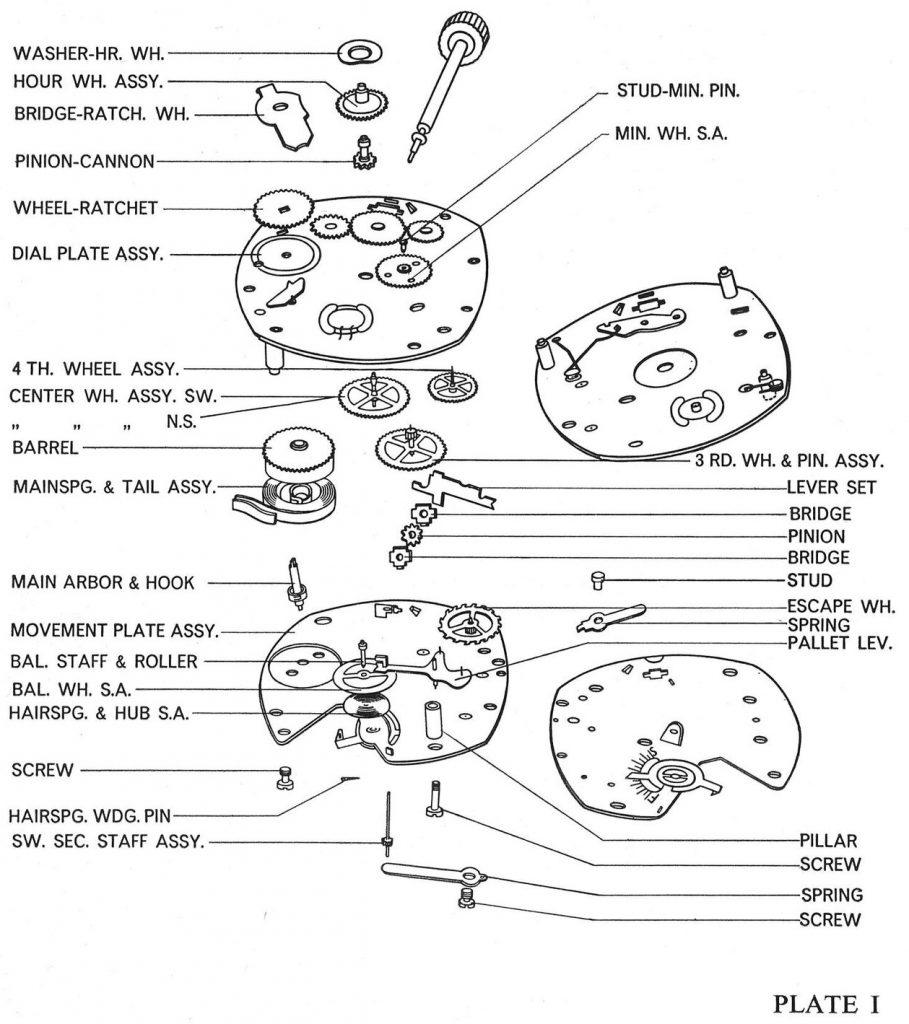
REMOVE CROWN AND STEM
On some models the winding stem must be removed before the movement can be taken out of the bezel. This is easily done with any pointed instrument preferably a pair of tweezers (A), which are brought down under the set lever (B) just above the winding stem (C) and gently levered upwards, then the winding stem can be freely pulled out. This operation can only be done with the winding stem in the wind position.
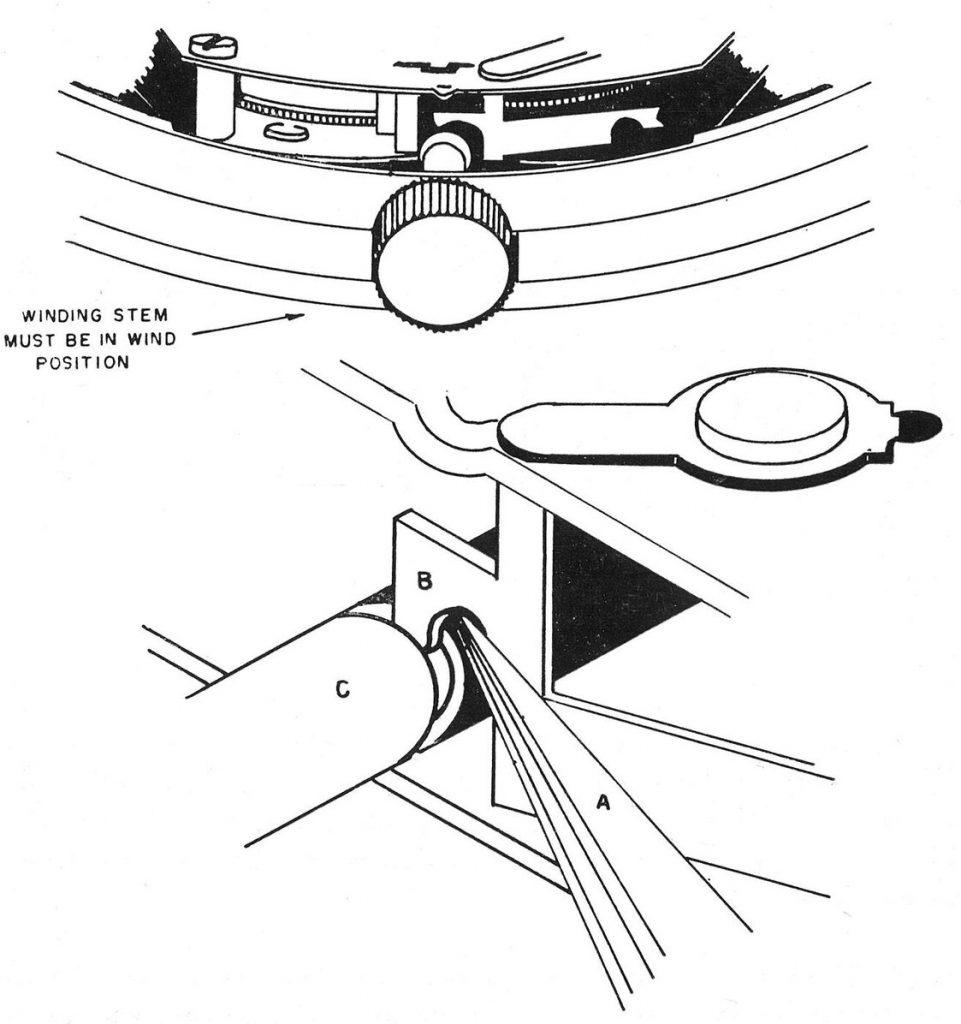
DUST SEAL LOCATION
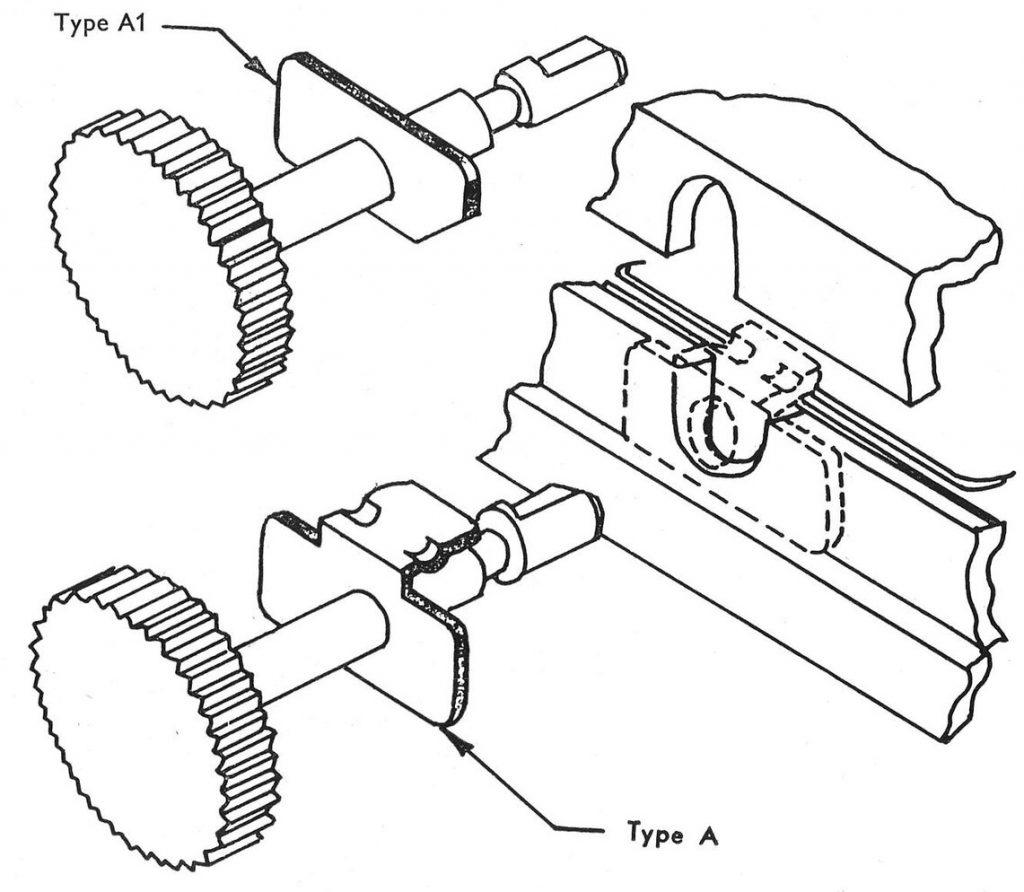
On newer non-waterproof models, the dust seals shown above are used. Type “A” is a formed metal seal with a bent tag. After being fitted to the winding stem, the bent tag should lie flat on the top face of the dial plate and the body of the seal placed between the caseback and bezel. The case should then be carefully closed.
Type “Al” is the same as type “A” except that the bent tag has been eliminated. It fits exactly the way type “A” fits except that the chamfered end should lie toward 12 o’clock,
PLATE III
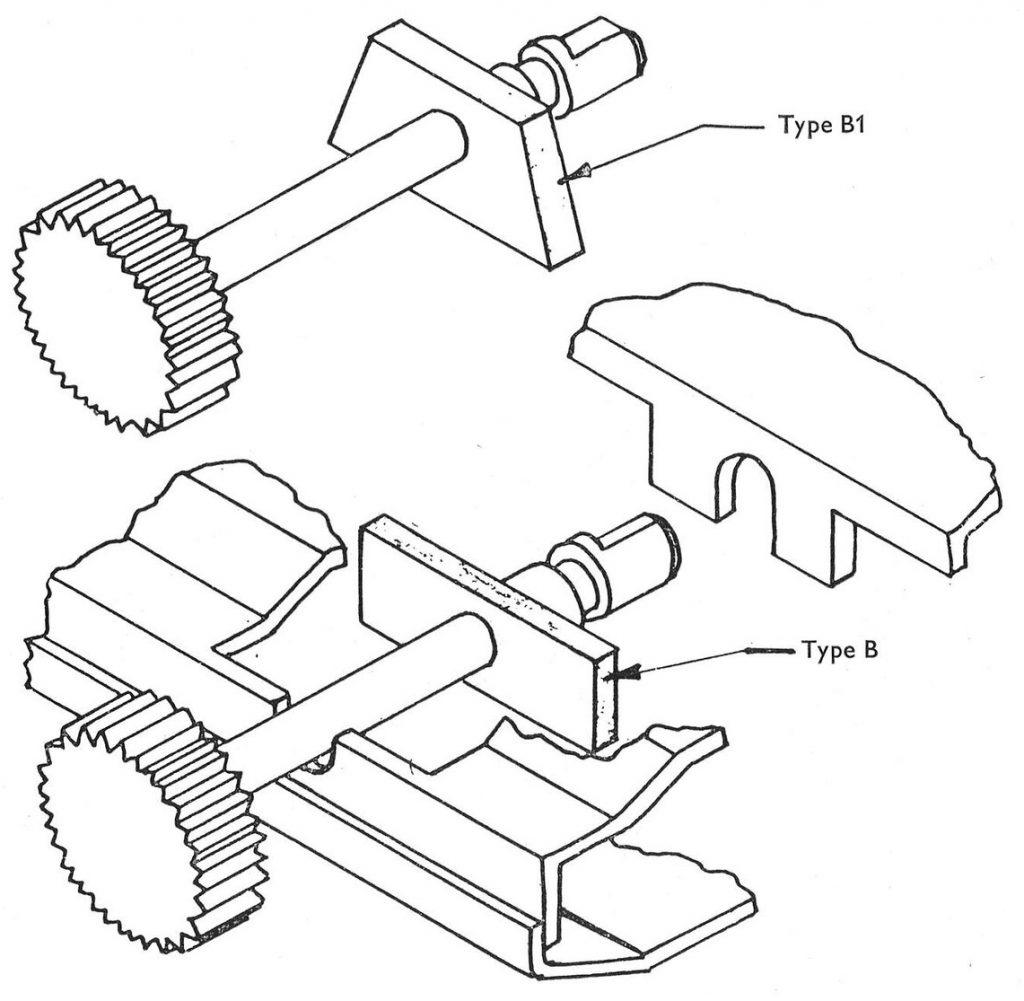
Another design of dust seal is shown here. Both types “B” and “Bl” are made of rubber and fit around the stem. Both seals must be located between the inside of the caseback and dial when the movement is in place prior to closing of the case. The shorter side of type “B 1” should lie towards the dial side of the move-ment.
PLATE III-A
REMOVE MOVEMENT AND DIAL ASSEMBLY
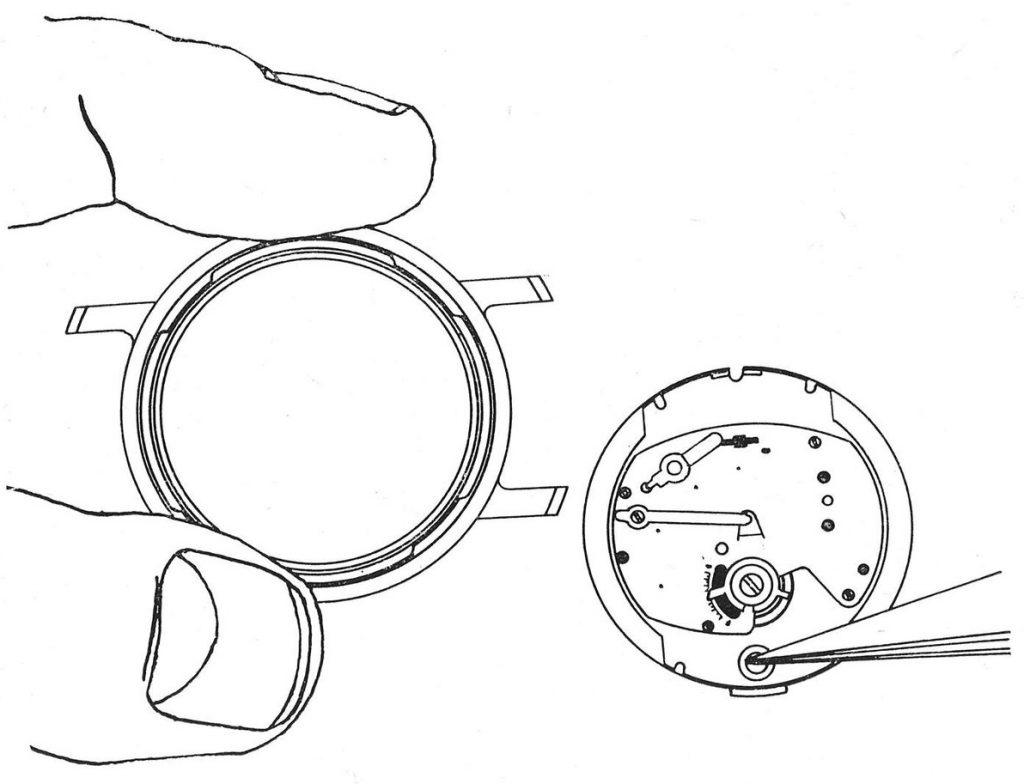
When removing the dial and movement assembly, insert the tweezers in the embossing on the dial holder.
PLATE IV
RELEASE POWER FROM MAIN SPRING
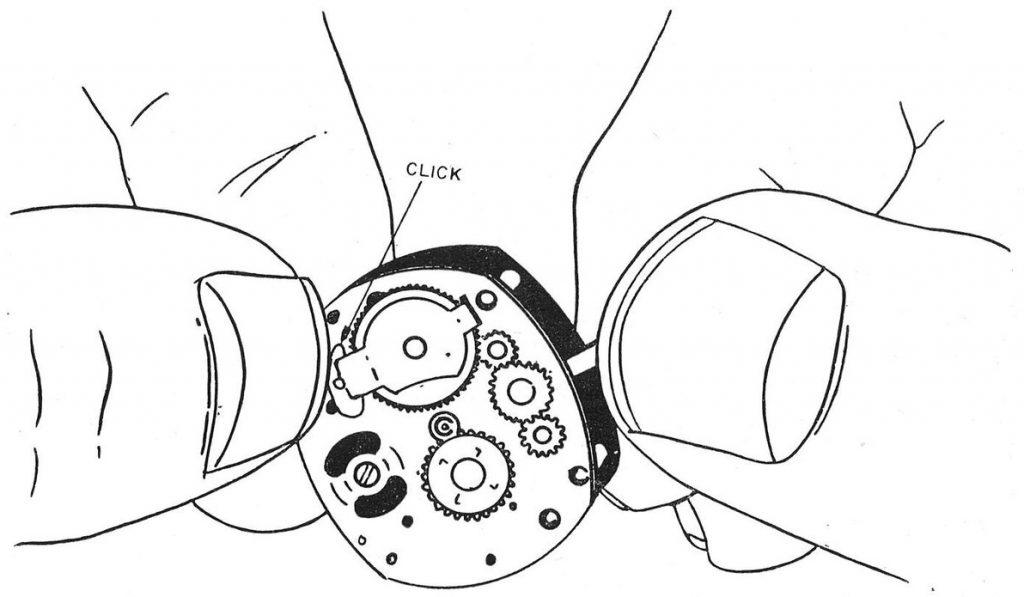
The power of the mainspring should next be released. To achieve this, the crown should be held lightly between the index finger and thumb of the right hand, while with the left thumbnail the click is released. The crown should be allowed to revolve slowly between the two fingers of the right hand until the power of the spring is completely released. Sudden release of power may do harm to the mainspring.
PLATE V
REMOVING BALANCE WHEEL
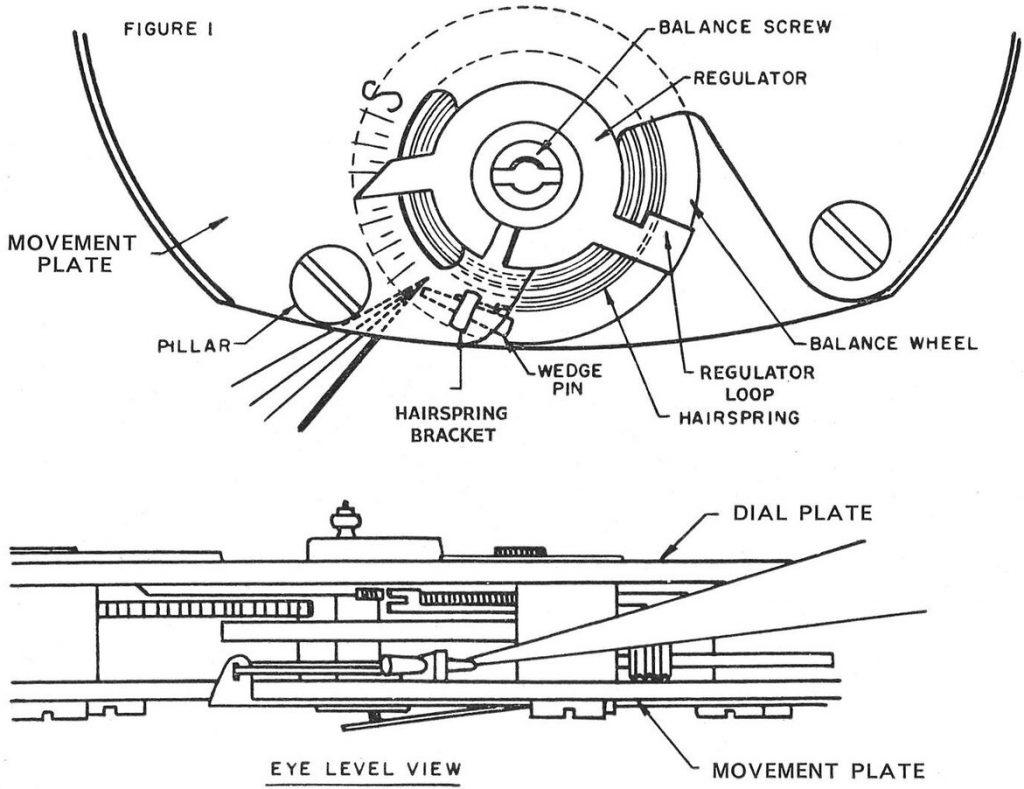
The small wedge pin holding the hairspring anchored to the bracket in the movement plate should be loosened and removed. Figure 1 shows the complete operation of removal by inserting tweezers between the dial plate and the movement plate using the tubular pillar as a support for tweezers. Care should be taken as not to harm either the hairspring or balance wheel.
PLATE VI
CHANGE BALANCE WHEEL
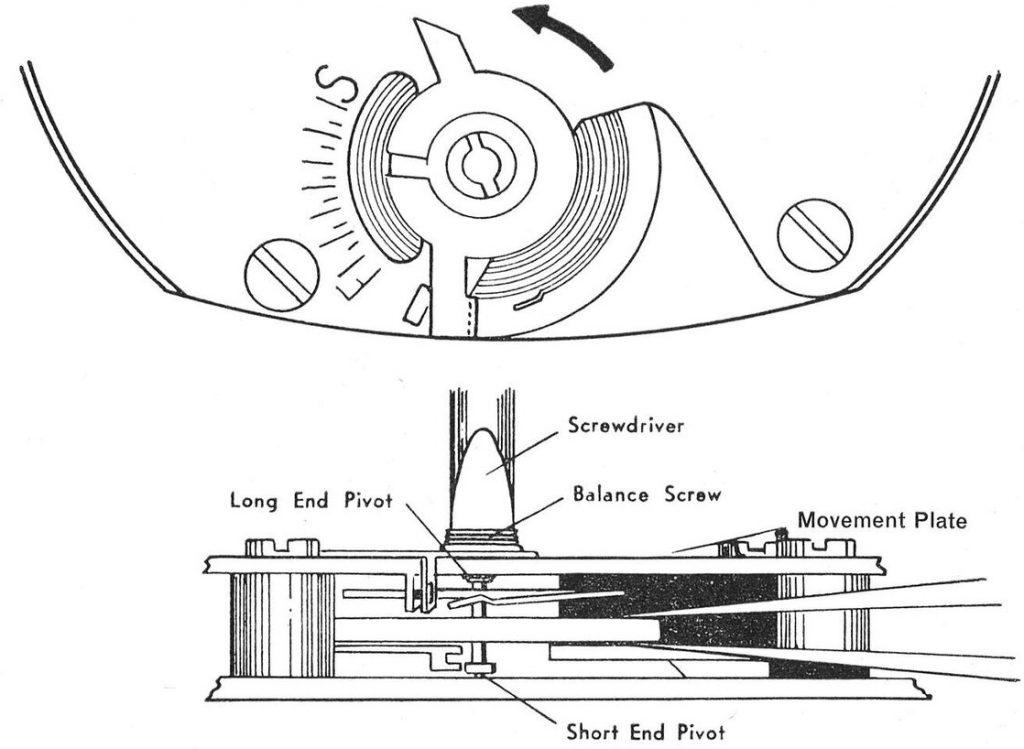
By carefully turning the balance wheel (arrow direction), it should be checked that the hairspring is freed from its contact with the hairspring bracket and regulator. The balance screw should then be unscrewed, using a screwdriver with a blade to fit the full length and breadth of slot. (Care should be taken that minimum downward pressure is applied to the screw, since any excessive pressure may result in possible damage to the radiused bearings of the balance staff.) The balance is now easily removed by inserting tweezers and gently removing. To replace balance — The balance is carefully inserted into the movement. Long end pivot (hairspring) side must enter first, by means of tilting, then the balance is lowered into dial plate V-conic bearing. The balance screw stud is then partially adjusted to retain assembly. The hairspring is then repinned by using the following procedure. First set regulator mid-way between the “fast” and “slow” positions with movement in the crown down position and viewing from dial plate. Sight the regulator loop and view the position of pallet lever. With index finger on rim of balance wheel, if the fork of the pallet lever is pointing inwards, rotate balance wheel to the left to engage the impulse pin with the fork and to bring the tail of the hairspring up to the loop of the regulator and hold with index finger on balance wheel. If the fork of the pallet lever is pointing outwards from the movement, with the index finger rotate the balance wheel to the right to engage the impulse pin with the fork and bring the tail of the spring up to the loop of the regulator. Using tweezers as stop against balance wheel if necessary to position tail of spring. With right hand tweezers guide tail of spring through loop or grasp tail of spring and thread through loop if necessary. Hold movement with crown down and dial plate towards you. Apply slight pressure on rim to stop motion of balance wheel and line up tail of spring with bracket, check visually position of impulse pin within fork, with right hand tweezers guide tail of spring into the hairspring bracket hole.
Position bend of hairspring on rim of bracket hole and using right hand tweezers grasp hairspring wedge pin and re-pin hairspring.
The balance end shake is then finally adjusted.
NOTE: The detailed explanation for pinning hairspring is necessary to ensure that the impulse pin engages correctly with the fork just prior to pinning on hairspring brackets. If the impulse pin is outside the fork slot, the hairspring must be unpinned and detailed procedures must be carefully followed. If this is not done and it is attempted to force the impulse pin into the fork slot, this will result in damage to the pallet lever and pallet pins.
REMOING PALLET AND ESCAPE WHEEL
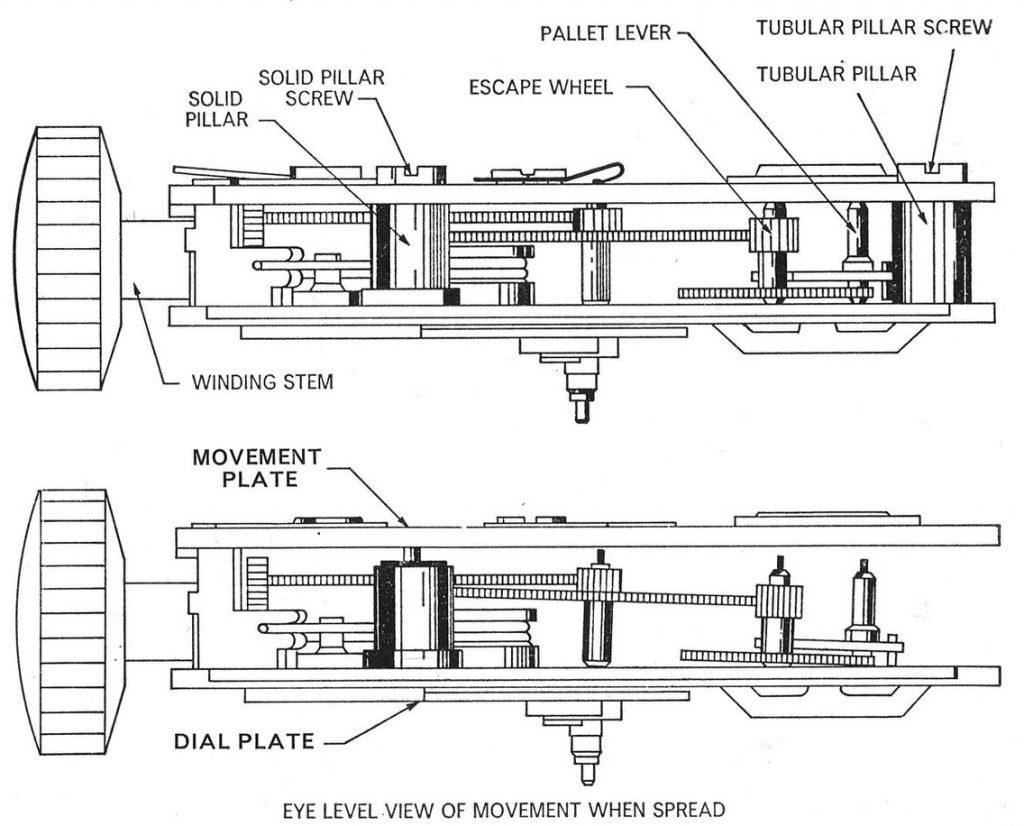
When removing the pallet lever and the escape wheel, the first operation is to unscrew the solid pillar screw and the tubular pillar screw. Then remove the tubular pillar. It is also important to loosen (about turn) the opposite solid pillar screw. (By doing this, there is less chance of distorting the movement plate during parts removal.) The winding stem must be left in the movement. This is important because it holds the winding bridge from falling out when spreading frames. When spreading movement plate from dial plate, the thumbnail is inserted between the movement plate and the solid pillar. The middle finger rests on the movement plate and pressure is applied, thereby raising the plate. The pallet lever and escape wheel staff are released from the location holes. Before changing the pallet lever and escape wheel, it is recommended that the balance wheel is also removed.
PLATE VIII
CHANGING PALLET AND ESCAPE WHEEL
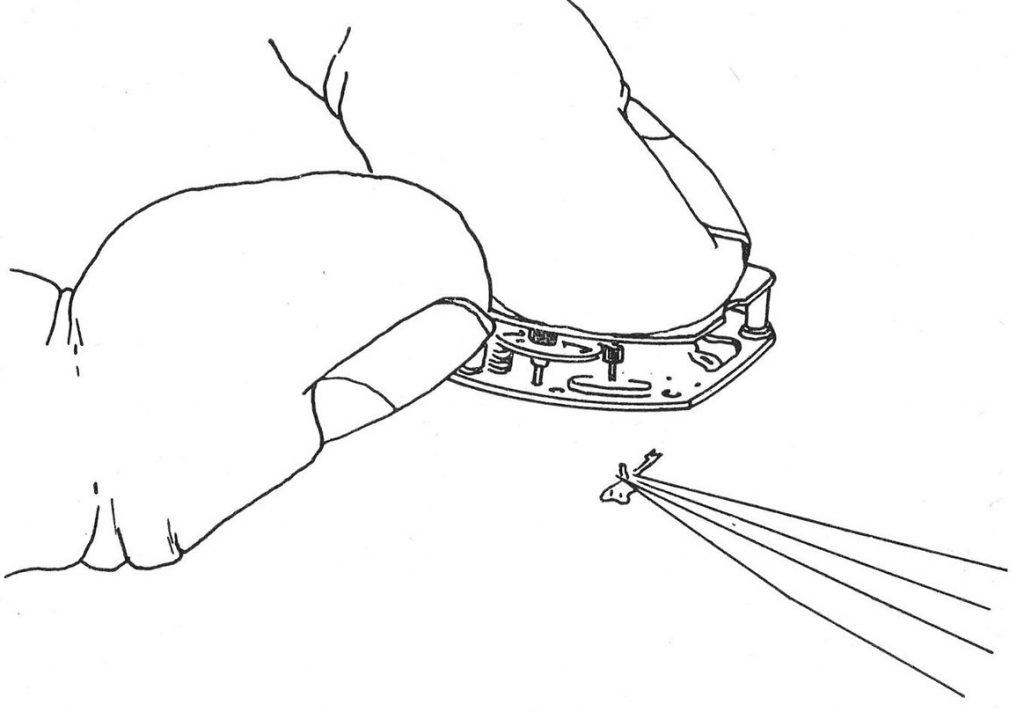
When the escape wheel and the pallet lever are released from their location holes the parts are now ready for removal. Tweezers are carefully inserted between the spread plates and holds the upper part of the pallet staff. A slight tilt releases the lower pivot of the pallet lever from its location in the dial plate. The pallet is then eased out of the movement. The same operation is applied to the escape wheel. When parts are replaced, the escape wheel is inserted first. Then followed by the pallet lever. It is an important factor to remember to place the pivots of the parts in their correct locations in the dial plate first. Finally the balance assembly is replaced using the method already described.
PLATE IX
REFITTING CANNON PINION
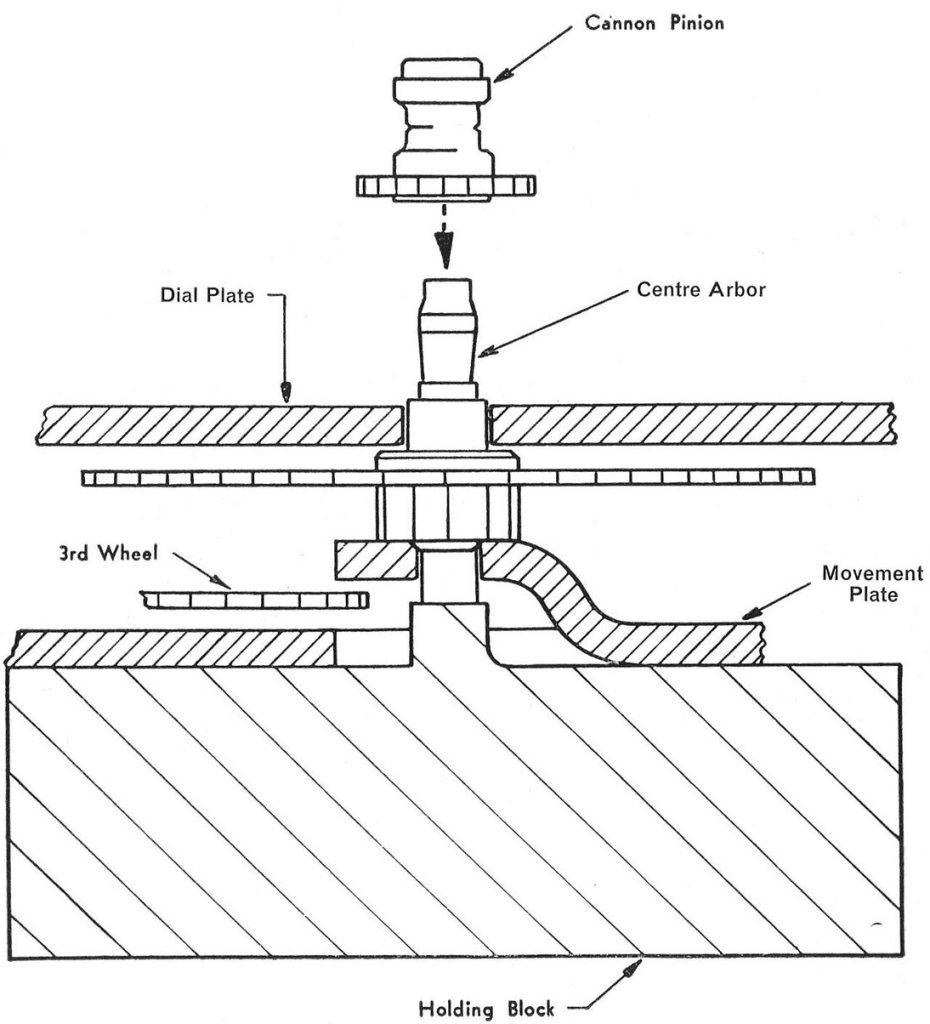
Before refitting cannon pinion a small amount of grease is applied to centre arbor. The movement is then positioned on holding block so that centre arbor is supported, care being taken to ensure that the centre arbor is fully raised and the shoulder correctly located in the plate hole.
The holding block is to be positioned so that it clears the third wheel.
PLATE X
TIMEX M29 MOVEMENT
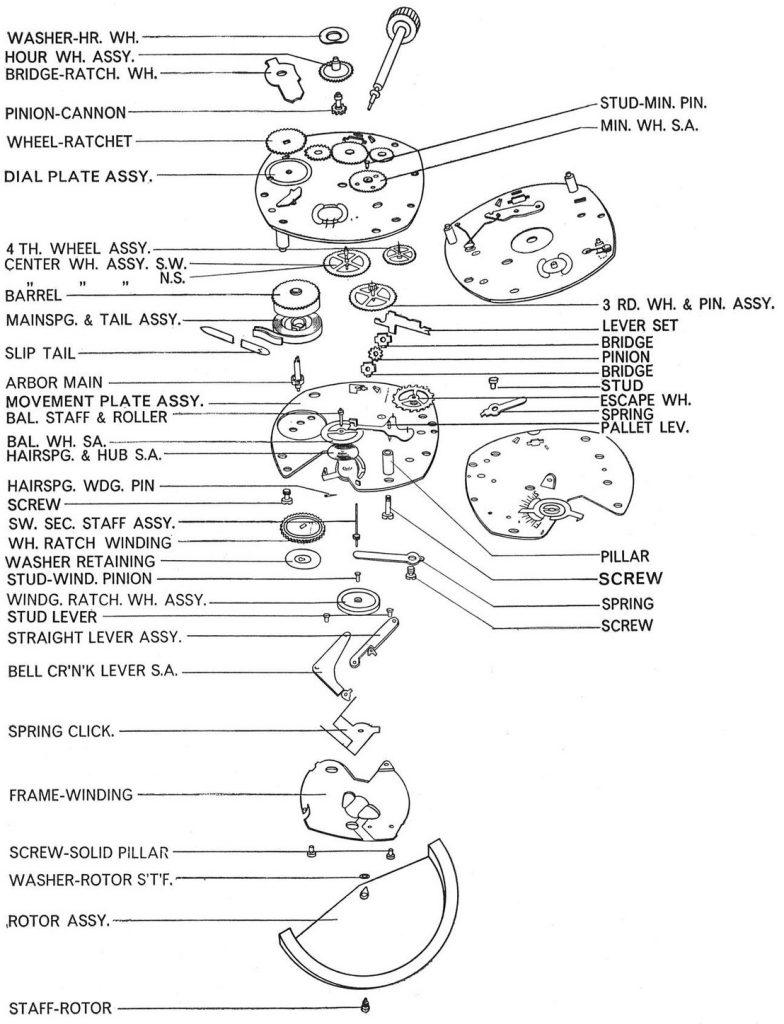
LUBRICATING THE MAIN SPRING SLIPPING TAIL
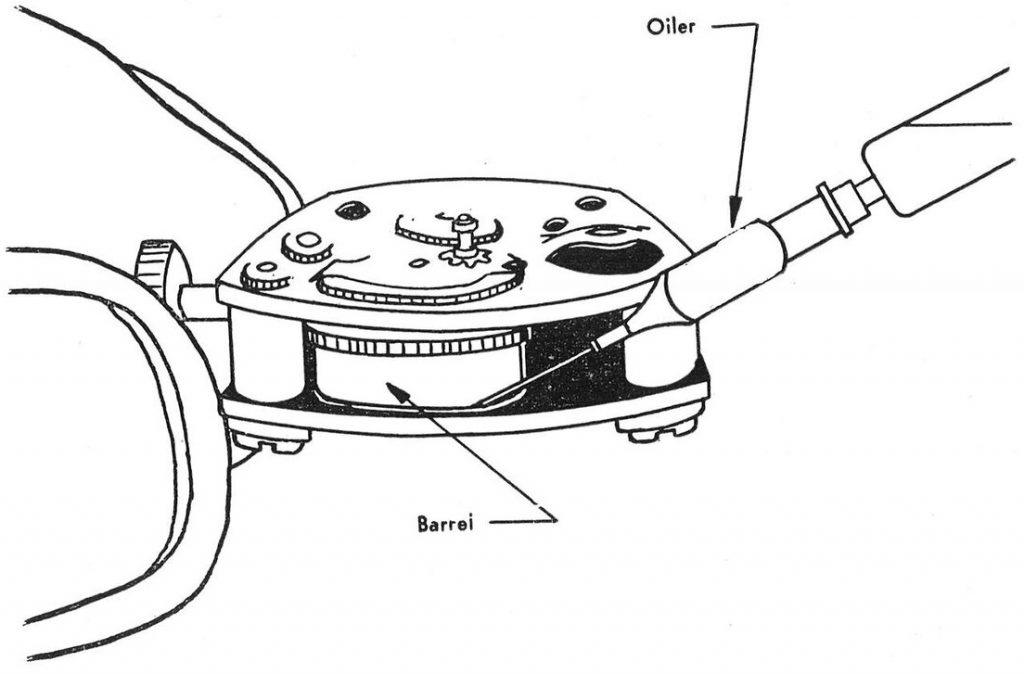
To introduce oil between the slipping tail and the inside of the barrel, hold the movement at about 45°, the barrel and dial plate uppermost. Using an oiler or paddle, wipe oil into the space between the outside diameter of the barrel and the barrel sweeping in the movement plate. This oil will work up between the slipping tail and the inside of the barrel.
PLATE XII
TIMEX M23 MOVEMENT
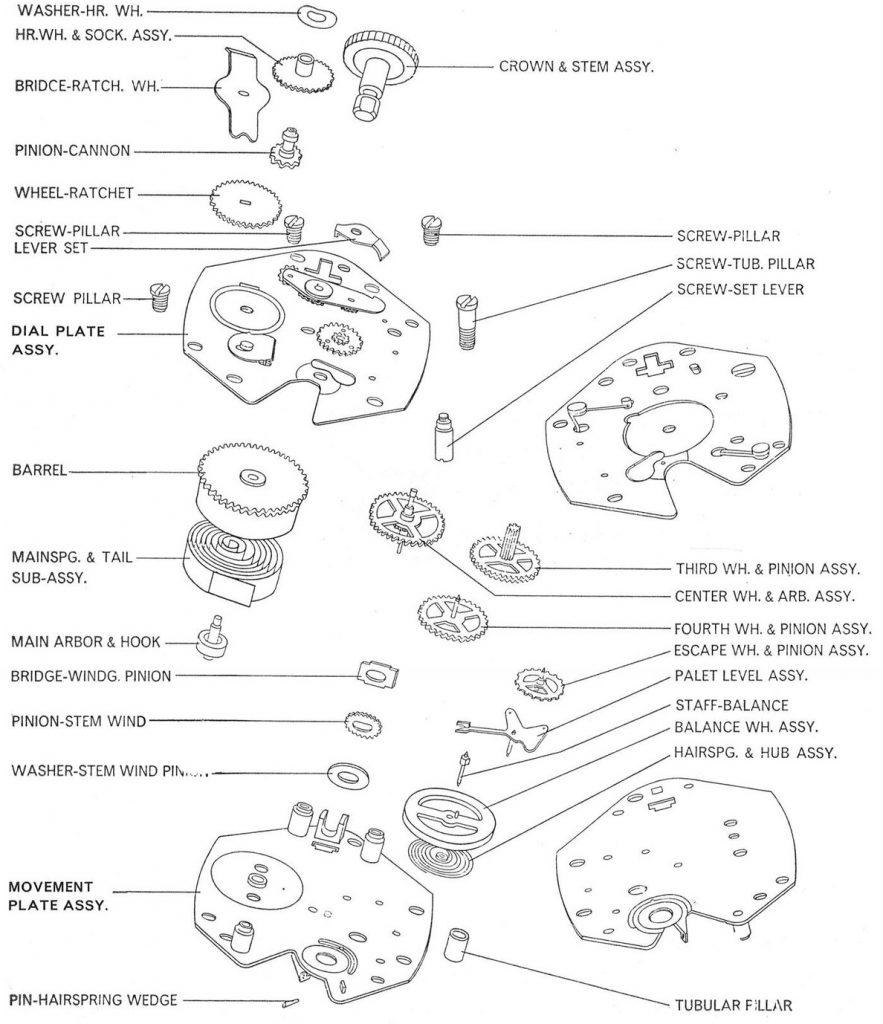
M23 WINDING STEM REMOVAL
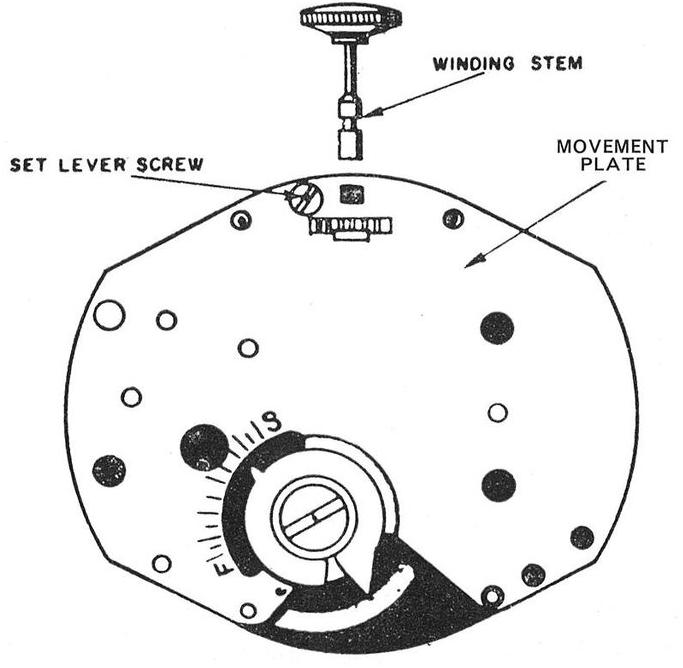
To remove the winding stem on the Model 23 movement, loosen the set lever screw, and pull the winding stem out.
PLATE XIV